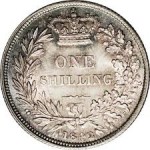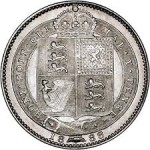A Scion Society of The Baker Street Irregulars
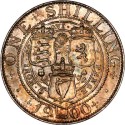
“Hey Pal, Can You Spare A ‘Bob’? – A Very Simplified Guide to Sherlock Holmes and Money of the Victorian Age
If anyone has experienced the thrill of a summer in Houston, Texas, you know indoor reading is one of few options left for survival. During the summer of my 14th year, as other young men were discovering their first love — fishing, or a summer job, I discovered the stories of the Canon. As I greedily followed the exploits of the Great Detective through my first (and still favorite) story, The Hound of The Baskervilles, I must admit I was much more enthralled by the action within the story than with scenic descriptions and character development.
Having the focus and patience of the typical teenager, many of the words used in the book were glossed over. After all, a game of “Pong” and episodes of Gilligan’s Island, The Munsters, Leave it to Beaver, I Love Lucy, and the Dick Van Dyke Show were using their siren song to call me back to the golden paradise, known as TV. I have to admit that during that first reading, I simply skipped over terms such as, “dolichocephalic”, “flagons and trenchers”, “Cyclopides”, or “tete-a-tete”.
I simply assumed that when I aged, retired, and had more time on my hands, I would break open the Funk & Wagnall and do a second reading. Now, I find I am almost there! Along with unknown terms, I also skipped over the mention of monetary denominations throughout the Canon. Guineas, florins, and farthings were just not interesting at that point.
As I finished my latest reading of the tales, I decided it was time to investigate further the different denominations, and what the money of that time was worth in comparison to today’s dollars. What could a pound back in the 1890’s purchase, and what did the average worker earn for his toils? I have developed this simple summary to answer my own questions. Hopefully, it may provide others with a rudimentary understanding of the money of Sherlock Holmes.

 February 15, 1971 will forever be known when the United Kingdom and Ireland converted. In other words, “Decimal Day” is the momentous holiday when the Brits and Irish were able to finally overcome a jealously they had experienced for years … the fact that us Yanks could use our fingers and toes to count money. Before this revolution occurred, the English monetary system was based on pounds, shillings, and pennies, with fractions represented by florins, farthings, and sixpence.
February 15, 1971 will forever be known when the United Kingdom and Ireland converted. In other words, “Decimal Day” is the momentous holiday when the Brits and Irish were able to finally overcome a jealously they had experienced for years … the fact that us Yanks could use our fingers and toes to count money. Before this revolution occurred, the English monetary system was based on pounds, shillings, and pennies, with fractions represented by florins, farthings, and sixpence.
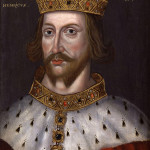
And just how did they determine to use a monetary system not based on the number 10, you might ask? Well, the pre-decimalization British system of coinage was introduced by King Henry II during the middle half of the 12th century. Henry was a busy man. Not happy just to change the money system, he also laid the groundwork for the modern English legal system, including the use of common law and a reformed jury system. Oh, and he also found time to have Thomas Becket, Archbishop of Canterbury and future saint, killed.
The system of coinage established by ol’ King Henry was based on the troy system of weighing precious metals. The penny was literally one pennyweight (approximately 1.5 grams, .05 ounces) of silver, compared to the modern U.S. penny, which weighs approximately 2.5 grams.
A pound sterling thus weighed 240 pennyweights, or a pound of sterling silver. Thus, 240 pennies equaled 1 pound. Hmmm… counting toes and fingers might be easier. Fast forward approximately 6 centuries, to the mid-1800s. As Victoria was entering her 17th year as monarch of the Empire (1837 – 1901), the most famous detective of all time was born in the Sussex region of England in 1854.
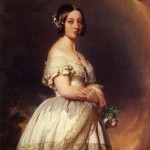 Before Holmes’ birth, coins of the realm depicted a very young looking Victoria on the obverse (front) of coins, from her coronation, while the Gothic Style look was introduced in 1847 for crown pieces and florins. These coins were still in use as young Sherlock may have been solving the problem of escaping the clutches of a nanny.
Before Holmes’ birth, coins of the realm depicted a very young looking Victoria on the obverse (front) of coins, from her coronation, while the Gothic Style look was introduced in 1847 for crown pieces and florins. These coins were still in use as young Sherlock may have been solving the problem of escaping the clutches of a nanny.
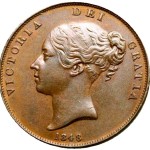
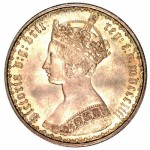
A young teen was probably already solving other childhood oddities, such as “The Case of the Missing Pie” (his brother Mycroft was the usual suspect), when the Queen was depicted with the “Bun Head” look. This style was used from 1860 to 1894, and adorned much of the bronze coinage of the time (penny, halfpenny & farthing issues).
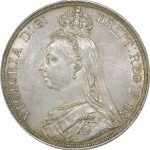
In 1887, the “Jubilee” styled coin was issued to celebrate the Golden Jubilee of reign by Queen Victoria. This style 1887-1892 corresponded with the time frame of Sherlock Holmes adventures from The Resident Patient through most of Sherlock’s self-imposed exile after The Final Problem.

In 1893, a motherly matriarch portrayal of the Queen appeared on all the coins of the Empire, until her death in 1901. This coincides with the return of Holmes in The Empty House, through to The Problem of Thor Bridge. These coins were known as the “Veiled or Widow” coins, and were probably the most used during the Holmes’ period.
One can only speculate after Victoria passed away, Watson musing to Holmes “I wonder if she will be happy in heaven?” Holmes matter-of-factly replying, “I don’t know. She will have to walk behind the angels–and she won’t like that!”
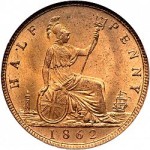 Take a look at the reverse (back) of many of the Victorian coins, and you will notice a female statue. The penny, farthing, and half penny all have a depiction of the ‘Britannia.’ During the ancient Roman times, Great Britain was given the name ‘Britannia.’ By the 2nd century, the islands were personified as a goddess, armed with a spear and shield and wearing a centurion’s helmet. Britannia is compared to the Miss Liberty symbol for the United States, and represents British unity and power. Just not quite as effeminate as Miss Liberty.
Take a look at the reverse (back) of many of the Victorian coins, and you will notice a female statue. The penny, farthing, and half penny all have a depiction of the ‘Britannia.’ During the ancient Roman times, Great Britain was given the name ‘Britannia.’ By the 2nd century, the islands were personified as a goddess, armed with a spear and shield and wearing a centurion’s helmet. Britannia is compared to the Miss Liberty symbol for the United States, and represents British unity and power. Just not quite as effeminate as Miss Liberty.

Britannia’s first appearance on British coinage was on the farthing in 1672. She consistently appeared on British coins 1707 to 2008. The model used, then and later, was Frances Teresa Stuart, the future Duchess of Richmond. Stuart was famous at the time for refusing to become the mistress of Charles II, despite the King’s strong infatuation with her. Usually not the smartest move. After marrying the Duke of Richmond, the king made a habit of assigning the Duke to posts in Scotland and Denmark (which was like being sent to Siberia!)
Before discussing specific coins, a side note on the writing down of coinage: Prices and wages for shillings and pennies were shown as (shillings / pennies), such as 11/7 (eleven shillings and seven pence, or spoken as ‘eleven and seven’). Amounts below a pound were written with slashes (/).
Using the example of four shillings and sixpence, the standard ways of writing shillings and pence were: 4/6. The sum of 4/6 would be spoken as “four shillings and sixpence” or “four and six”. You would write ‘4/-‘ for 4 shillings only, with the dash to stand for zero pennies. Amounts above a pound were written with dashes (-). A sum of 2 pounds, 12 shillings, and 7 pennies, would be written as £2-12-7.
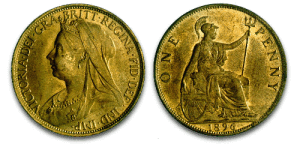
The penny was considered to be the basic unit of currency in Victorian England. The original pennies were minted around 785 AD, with the name coming from the Old English “Pennige,” which shares the same root as the German “Pfennig”. Originally, the Penny was made from silver, then copper from the 1790’s, and finally bronze from about 1860.
When writing money in terms of pennies, the lower case ‘d’ was used. This designation came from the Roman term, ‘Denarius’ (also shown as ‘denari’ or ‘denarii’). Denarius were small, and probably the most common silver Roman coin, loosely equating to one day’s pay for a laborer. So 3 pennies would be written as ‘3d’.
British pennies were often used in satirical humor to belittle another, or show the insignificance of an item. Once a former prime minister, David Lloyd George, said, “Winston, loan me a penny so I may ring a friend.” Churchill responded, “Here, David, is a sixpence. Now you can ring all your friends.” In The Hound, Holmes states, “There is as much difference to my eyes between the leaded bourgeois type of a Times article and the slovenly print of an evening halfpenny paper…”
There is debate as to the original term “pound sterling,” however, most believe it refers to the Anglo-Saxon period, when “sterling” silver coins were being minted; 240 of these coins (pennies) weighed 1 pound. Thus, 240 pennies equaled 1 pound. When large amounts of these coins were exchanged, it was considered to be a payment in “pounds of sterling.”
The sign for the pound coin was originally an “₤” with two cross-bars, then simplified to “£” with one cross-bar. The “£” and” L” symbols were derived from the Latin term ‘libra’, which denoted a pound weight. In the zodiac universe, the ‘Libra’ sign is represented by the weighing scales.
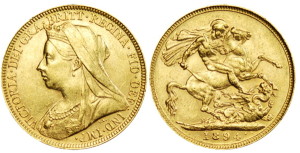
During Sherlock Holmes era, the pound was most commonly found as a gold coin, known as a “sovereign.” A Pound note, made out of paper, was known as a “quid.” The front face of the coin (the “obverse) portrayed a bust of Victoria, with a long surrounding Latin phrase, extolling her position. On the back of the coin (“the reverse”), St. George, the patron saint of England, is portrayed slaying a dragon. A dragon ? Maybe on Chinese coins, but British Victorian era coins?
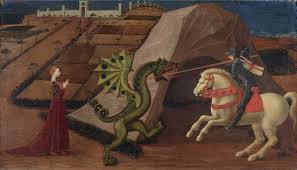 According to legend, a dragon made its nest at the spring that provided water near a city in Libya. Residents were forced to offer either a sheep or a maiden for sacrifice. One such day, the princess was randomly selected to be the sacrifice. As she is offered to the dragon, St. George arrives, slays the dragon, and rescues the princess. The grateful citizens abandon their ancestral paganism and convert to Christianity. This led to canonization and the beloved adoration of British citizens.
According to legend, a dragon made its nest at the spring that provided water near a city in Libya. Residents were forced to offer either a sheep or a maiden for sacrifice. One such day, the princess was randomly selected to be the sacrifice. As she is offered to the dragon, St. George arrives, slays the dragon, and rescues the princess. The grateful citizens abandon their ancestral paganism and convert to Christianity. This led to canonization and the beloved adoration of British citizens.
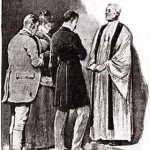 The pound, or sovereign, is mentioned throughout the Canon, as a reference to salaries, rewards, or to pay off a bet. Such an example can be found in A Scandal in Bohemia, where Holmes is paid as a witness… “The bride gave me a sovereign, and I mean to wear it on my watch-chain in memory of the occasion.”
The pound, or sovereign, is mentioned throughout the Canon, as a reference to salaries, rewards, or to pay off a bet. Such an example can be found in A Scandal in Bohemia, where Holmes is paid as a witness… “The bride gave me a sovereign, and I mean to wear it on my watch-chain in memory of the occasion.”
The guinea was minted in the United Kingdom between 1663 and 1813, but not during Holmes’ period. It was the first English machine-struck gold coin (the gold coming from the African area of Guinea), originally worth one English Pound sterling. By the Victorian era, the guinea was no longer in circulation, but was still being used as a “virtual coin.”
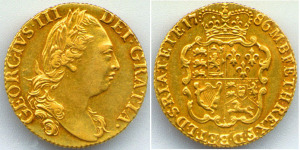
This usage carried on into the 20th century. During the Holmes’ period, the guinea was valued at 21 shillings, or 1 pound and 1 shilling.
Payments made in guineas were considered more gentlemanly. Common laborers were paid in pounds. Professionals, such as artists or physicians, were paid with the higher denomination. Such was the case in the Adventure of the Engineer’s Thumb, when a stranger offers Mr. Hatherly a unique proposal, “How would fifty guineas for a night’s work suit you?” he asked.
Below the pound denomination was the shilling. 1 shilling equaled 12 pennies (or pence), and 20 shillings equaled 1 pound. The symbol “S” represented the shilling, taken from the Roman coin ‘Solidus’, meaning ‘solid coin’.
The term “shilling” originally was spelled “scilling” or “skilling”, meaning to sound or ring, as well as defined as ‘to split or divide’.
There were three main types of Victorian shillings, with several varieties under each major type. Type One had a young version of Queen Victoria on the obverse. On the reverse, the words “ONE SHILLING” was imprinted.
Type Two shows the Jubilee portrait of Victoria on the obverse and a shield in a garter on the reverse. Type Three variety shows the veiled ‘Old Head’ of Queen Victoria on the obverse and three shields within a garter on the reverse, with a rose between the upper two shields.
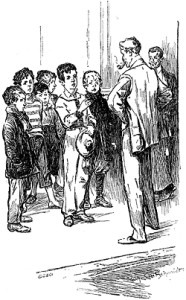 Often, when Holmes made use of his street urchin detective crew, the Baker Street Irregulars, their pay would entail shillings. In A Study in Scarlet, Watson reported, “He handed each of them a shilling. ‘Now, off you go, and come back with a better report next time.’”
Often, when Holmes made use of his street urchin detective crew, the Baker Street Irregulars, their pay would entail shillings. In A Study in Scarlet, Watson reported, “He handed each of them a shilling. ‘Now, off you go, and come back with a better report next time.’”
In addition, in The Sign of Four, Holmes works with the Irregulars, “… He handed them a shilling each, and away they buzzed down the stairs, and I saw them a moment later streaming down the street…”
Remember earlier we discussed coinage syntax. Adding the s, d, and L, using the example of four shillings and sixpence, the standard ways of writing shillings and pence were: 4s 6d or 4/6. A sum of 2 pounds, 12 shillings, and 7 pennies would be written as £2 12s 7d or £2-12-7.
Ok, so we have provided information on the 3 basic coins: the shilling, penny, and pound/guinea. However, there were several other coins used during the Victorian period, and were also mentioned in the Canon.
The British halfpenny coin was worth 1/480th of a pound sterling. It was originally minted out of silver, but as the value of the pound declined, the coin was made from base metals. The first halfpennies were literally pennies cut in half.
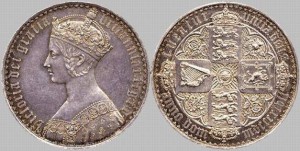
The Queen Victoria Crown from 1847 is considered to be one of the most beautiful designed coins in British history. The crown was worth 5 shillings (or 60 pence), and was the basis of other denominations, such as the half crown and double crown. The obverse portrays an young Victoria. The reverse features the various elements of the royal coat of arms.
The gold half-sovereign is similar to the sovereign in design and amounts minted. The coin was first issued in 1544, under the reign of Henry VIII. Until 1887, the crowned shield was portrayed on the reverse. Victoria, in 1887, adopted the St. George and dragon reverse. The half-sovereign was worth 10 shillings, or 120 pence.
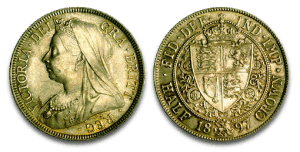
The gold half crown was first issued in 1526 during the reign of Henry VIII. Silver half crowns first appeared in 1551. The older Victorian half crown was valued at two shillings and sixpence, or 30 pence.
The silver florin was Britain’s first decimal coin. The florin was issued to test whether a decimal-based coin would be accepted. It was worth 2 shillings, or one tenth of a pound. On the first design, the value is shown as “One Florin – One Tenth of a Pound.” In 1887, the value was entirely removed, assuming everyone knew its value. In 1893, with the “Old Head” design, the value mark reappeared, with the wording, “One Florin – Two Shillings.”
The first sixpence was coined in 1551. It was issued to ease the devaluation of other silver coins. In 1887, Queen Victoria’s golden jubilee called for new designs.
The half sovereign and the sixpence shared the same reverse design. Soon, forgers realized by gilding (“gold plating”) sixpences, they could easily be passed off as half sovereigns. The coin was quickly redesigned, with “SIX PENCE” crowned within a wreath. The sixpence was worth one-half shilling, or 1/40th of a pound.
Before 1279, if change was needed, a penny was divided into two halves, or four quarters. This was known as halving or fourthing. Farthing was probably derived from fourthing. The first silver round farthing was issued from 1279 under Edward I.
In the U.S., different currencies have attracted a variety of “slang” or “alternative names” to describe the denomination, such as “two-bits, c-note, or a saw-buck,” which represented a quarter, $100 bill, and a $10 bill, respectively. Over the years, many of the coin denominations in England also acquired these slang names, usually used among the common population. These terms were not as prevalent among the upper class.
For example, a pound or a number of pounds was known as “quids” or “nickers.” “Quid” started being used in the late 1600’s, coming from the Latin phrase, “quid pro quo” – “something for something.” Obviously in The Adventure of the Mazarin Stone, the two thieves felt they were getting something for something… “What! Give it up? Give up a hundred thousand quid?” A penny was often called a copper, after the copper metal used in the minting process. Many slang expressions for old English money started in London, the center of a vast and diverse population. Different communities developed their own language, being very territorial in their usage. In addition, the use of backslang, where the sound of the word was reversed, was used by vendors in describing money and coins. For example the term “yob” would be used in lieu of “boy.”
Shilling – “Bob” – Origin of the word not known for sure. Possibilities include a connection with the church or bell-ringing since ‘bob’ meant a set of changes rung on bells. This would be consistent with root of the word Shilling, (from Germanic ‘skell’ meaning to sound or ring). In Sign of Four, “Got your message, sir,” said he, “and brought ’em on sharp. Three bob and a tanner for tickets.”
Six Pence – “Tanner” – Derived from Romany gypsy ‘tawno’ meaning small one, and Italian ‘danaro’ meaning small change. In Sign of Four, “Got your message, sir,” said he, “and brought ’em on sharp. Three bob and a tanner for tickets.”
Pound – “Quid ” -From Latin, quid meaning ‘what’, as in ‘quid pro quo’ – ‘something for something else’. In Mazarin Stone, “What! Give it up? Give up a hundred thousand quid?”
Guinea – “Yellow Boy” – Originated as anything gold in color
Salaries / Costs in the Holmes Era
To better understand the costs and salaries of the 1890’s, it helps to translate the Pound Sterling into today’s dollars. It is impossible to precisely calculate what an 1890 Pound would be worth today, but estimates average £80, when considering retail prices. One British Pound equals approximately $ 1.60 (US) at today’s exchange rates. Which in turn translates to an 1890 £1 coin having the buying power of approximately $100.00 today. As a contrast, the exchange rate in 1890 put £1 at a par with $ 5.10 during the same time period.
Looking at wages earned in the 1890’s… the average annual wage for all employees was around £660 (however, very high wages by the upper class skew the data; the average common laborer averaged around £60 per year)…
As an example, assume an up and coming professional living around 1890. He might earn a salary of approximately £700 / year. His expenses, which would include: rent (up to £150 annual), taxes, maids (2), food, laundry, heating (coal), electricity, alcohol, insurance, clothing, and savings would add up to close to £500. This would leave approximately £200 for other expenses (transportation, entertainment, education, etc.).
On the low end, look at a common laborer who might earn £100/year as a carpenter. His rent might be as low as £10-15 per year for a one room flat. Maids and valets would earn between £10-40 annually, while a butler would be paid approximately £45-50 per annum. Most common laborers earned somewhere between £20-80.
As an example, Conan Doyle himself, in his third year of medical practice, earned approximately £300 per annum. At the low end, a medical doctor might earn as little as £100-150 annually, and toward the top end, £350. So Conan Doyle had established a solid practice by his third year.
In simple terms, there were 3 levels of social classes during Holmes’ time:
• Working class – men and women who performed physical labor, paid daily or weekly wages
• Middle class – men performed mental or “clean” work, paid monthly or annually
• Upper class – did not work, income came from inherited land and investments
The job of Telegraph Messenger Boys was introduced in the 1870’s. These boys would deliver telegrams and carry blank forms for people to send their replies. It cost six pence to send 12 words and a halfpenny for every additional word.
Miscellaneous Expenses
• A dentist would charge you 5/3 (5s 3d) for filling a tooth
• The minimum cost for a funeral was approximately £4
• A full set of false teeth cost £21
• A box in the Royal Opera House cost £8,000
• A beer costs approximately $1.45 in today’s prices
So there you have it… I hope a simplified approach to the money of Sherlock Holmes and of the Victorian period in the late 1800’s.
I know for myself, the next time I read through a story in the Canon, and see where Holmes gave a shilling for someone’s assistance, I understand that would be enough for me now to buy half a movie ticket, or maybe a value meal at a fast food restaurant.
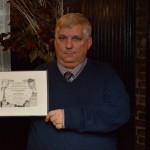 Steve Mason, the 19th Garrideb, is the Third Mate of the Dallas scion, the Crew of the Barque Lone Star. In addition, Steve serves as the webmaster and Communications Chair for the Beacon Society, a non-profit group that strives to have Sherlock Holmes taught in the classrooms of schools around the country. Mason was honored as the 2016 winner of the Jan WHIMSEY (Whimsical Humour is my Specialty. Enjoy Yourself.) Award for the most whimsical article published in the 2015 editions of The Serpentine Muse, the official publication of the Adventuresses of Sherlock Holmes
Steve Mason, the 19th Garrideb, is the Third Mate of the Dallas scion, the Crew of the Barque Lone Star. In addition, Steve serves as the webmaster and Communications Chair for the Beacon Society, a non-profit group that strives to have Sherlock Holmes taught in the classrooms of schools around the country. Mason was honored as the 2016 winner of the Jan WHIMSEY (Whimsical Humour is my Specialty. Enjoy Yourself.) Award for the most whimsical article published in the 2015 editions of The Serpentine Muse, the official publication of the Adventuresses of Sherlock Holmes

